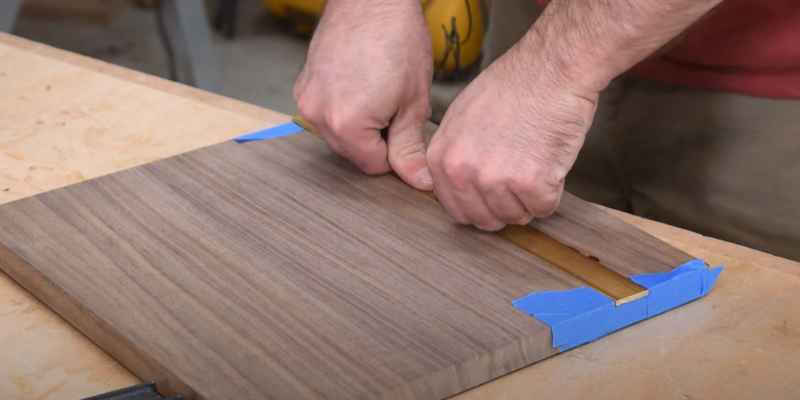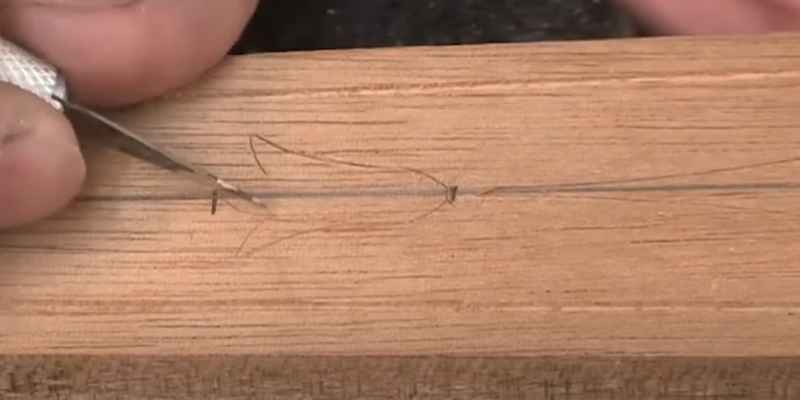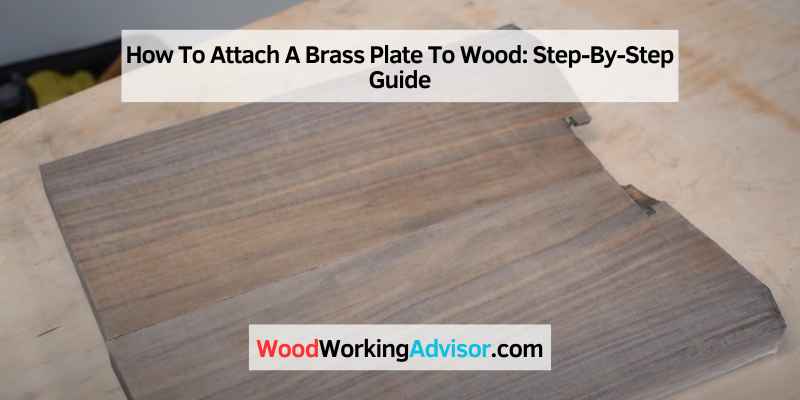You can attach a brass plate to wood in a few different ways. You can use screws, nails, or even glue. It all depends on what type of look you are going for and how permanent you want the attachment to be.
If you are looking for a more temporary attachment, screws or nails would probably be the best option. But glue would be your best bet if you want the brass plate to be attached more permanently.
- Decide where you want to attach the brass plate to the wood
- Use a measuring tape to measure the area and mark it with a pencil
- Cut out the marked area using a saw
- Apply glue to the back of the brass plate and attach it to the cut-out area on the wood
- Press down on the plate firmly and wait for the glue to dry completely before moving on

How Do You Attach Brass to Wood?
There are a few different ways to attach brass to wood, depending on the project you are working on and the look you are going for. If you want a more permanent attachment, you can use screws or nails. Predrill pilot holes in the wood and screw or nail the brass piece into place.
For a temporary attachment, you can use double-sided tape or glue. Just be sure to test whatever method you use first on a scrap piece of wood to make sure it adheres properly and won’t damage your finished project.
What Can I Use to Glue Brass to Wood?
There are a few different options for gluing brass to wood. One option is to use a product called J-B Weld. This product is designed for bonding metal to metal and can be used on brass and wood.
Another option is to use epoxy glue. This type of glue will also work on brass and wood, but it may not be as strong as the J-B Weld. Finally, you could also use super glue or other types of adhesives.
These may not be as strong as the other two options, but they will still work for most applications.
How Do You Attach Metal Plate to Wood?
There are a few ways to attach metal plates to wood, but the most common and effective method is to use screws. First, determine where you want the metal plate to be attached to the wood. Then, using a drill bit slightly smaller than the diameter of the screw, create a pilot hole in the center of each attachment point on the metal plate.
Next, insert a screw into each pilot hole and tighten until snug. Be careful not to overtighten, as this can strip the threading or damage the wood. Finally, apply a small amount of glue around the perimeter of the metal plate, if desired, for added stability.
What is the Best Adhesive for Metal to Wood?
A few different types of adhesives can be used to adhere metal to wood, but the best one to use depends on the project you’re working on. For example, an epoxy adhesive would be your best bet if you need a strong bond that can withstand heavy loads or extreme temperatures. On the other hand, if you’re looking for a more temporary solution or one that’s easier to remove later on, then a hot glue gun would suffice.
When it comes to choosing an adhesive for metal-to-wood projects, there are a few factors you need to consider. First and foremost is the type of metal you’re using – some metals are more difficult to bond than others. You’ll also need to consider the weight of the metal and how much stress it will be under once it’s attached to the wood.
And finally, you need to decide what kind of finish you want for your project – do you want it to be smooth and seamless, or does a minor imperfection add character? Once you’ve considered all of these factors, it should be relatively easy to choose the best adhesive for your project. If you’re still unsure, consult with a professional or ask someone at your local hardware store for advice.
Glue Brass to Wood
It’s not challenging to glue brass to wood, but it is essential to choose the right type of glue and follow the proper steps. Here’s what you need to know: A two-part epoxy is the best bond for this project.
It forms a strong bond and dries clear, so you don’t have to worry about discoloring your brass or wood. To get started, clean both surfaces with isopropyl alcohol. This will remove any oils or dirt that could prevent the glue from adhering properly.
Next, mix equal parts of the epoxy resin and hardener. Apply it to one surface using a toothpick or other small tool, then firmly press the two surfaces. Let the glue dry for at least 24 hours before handling or adding any weight to the joint.
Once fully cured, your brass and wood piece will be firmly attached!
How to Attach Metal to Wood Without Screws
There are several options available if you’re looking for a way to attach metal to wood without using screws. You can use glue, tape, or even magnets to keep your metal attached to the wood. Bond is one of the most common methods for attaching metal to wood.
You can use any glue that works with both materials. Apply a generous amount of glue to the metal and the wood, then press them together firmly. Hold it in place for a few minutes until the glue dries, then let it cure overnight before putting it to use.
Tape is another option that can be used to attach metal to wood. Double-sided tape is the best type of tape to use, as it will provide a stronger hold than regular tape. Just apply the tape to both surfaces, press them together firmly, and hold them until the adhesive sets.
Magnets are also an option for attaching metal to wood. This method is best used with smaller pieces of metal, as more significant amounts may be too heavy for the magnets alone to hold up.
Strongest Glue for Metal to Wood
There are a few different types of adhesives that you can use to glue metal to wood, but some are stronger than others. For example, epoxy is a powerful adhesive that can be used for this purpose. However, it is also quite challenging to remove once it dries, so you need to be sure that you want the metal attached to the wood before using this type of glue.
Super glue is another solid and easy option, but it can be difficult to remove if necessary. Welding is another possibility for attaching metal to wood, but it requires special equipment and training.

Best Glue for Aluminum to Wood
There are a few different options available when it comes to gluing aluminum to wood. However, not all of these options are created equal. It would be best if you chose a suitable glue to get the best possible bond between these two materials.
One option is epoxy. Epoxy is solid and creates a very durable bond. It can also be used on various surfaces, making it a versatile option.
However, epoxy can be challenging and doesn’t always create a seamless bond. Another option is polyurethane glue. This glue is much easier to work with than epoxy and creates a powerful bond.
It’s also waterproof, which makes it ideal for outdoor applications. However, polyurethane glue can be more expensive than other options. The third option is cyanoacrylate glue, also known as super glue.
This type of glue dries quickly and forms a powerful bond. It’s perfect for small projects or repairs requiring a quick fix. However, cyanoacrylate glue can be challenging to remove once it’s dried, so you must be careful when using it.
No matter which type of glue you choose, test it out on a scrap piece of aluminum and wood before using it on your project.
Conclusion
Attaching a brass plate is an excellent option if you’re looking for a way to add a class to your woodworking projects. Here’s a quick guide on how to do it: 1. Start sanding the area where the brass plate will be attached.
This will help create a smooth surface for the adhesive to adhere to. 2. Apply adhesive to the back of the brass plate and press it into place on the wood. Hold it there for a few minutes until the adhesive sets.
3. Use a hammer and nail set to tap nails around the plate’s perimeter gently. Be careful not to damage the brass or wood as you do this. 4. Finally, apply some clear sealant over the top of the entire assembly to protect it from scratches and wear over time.


